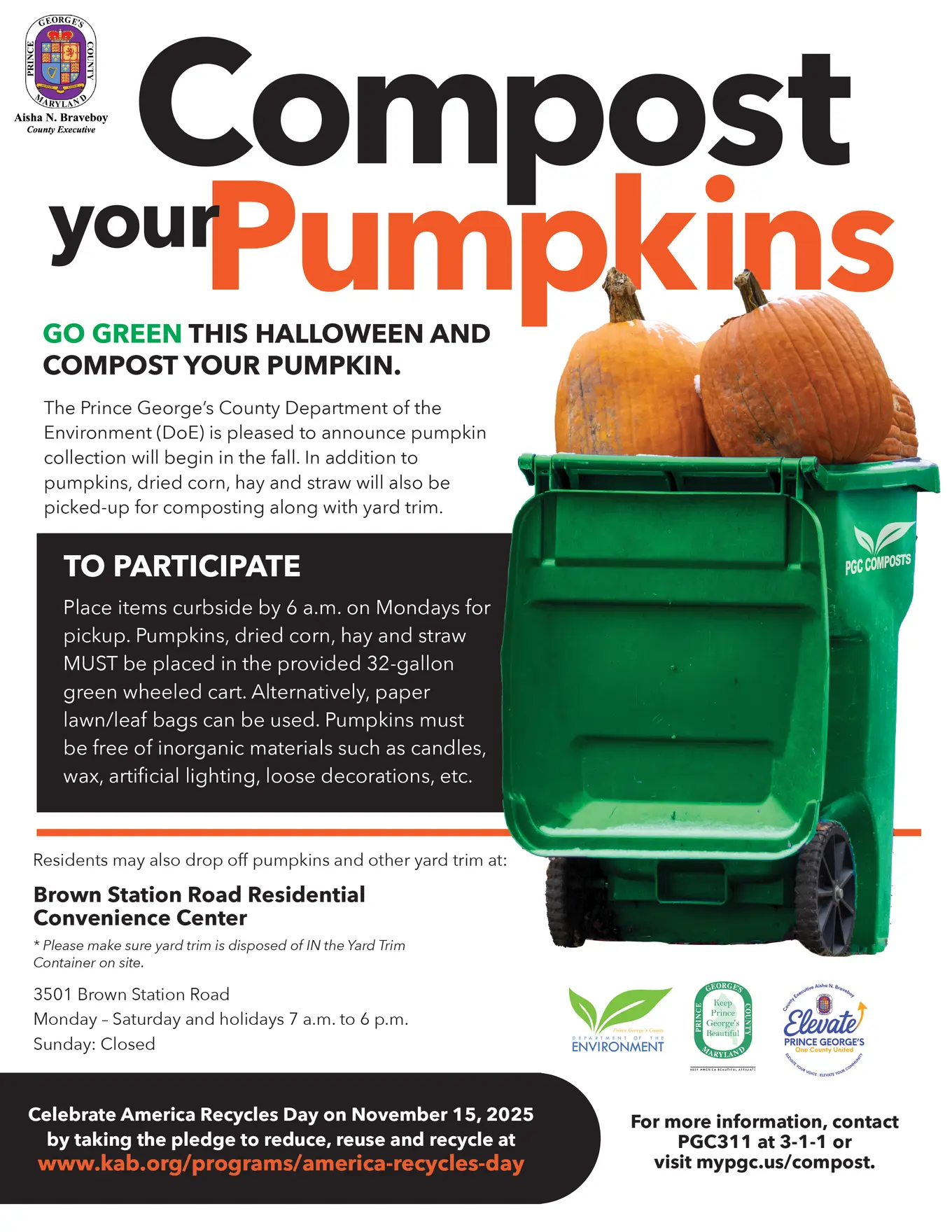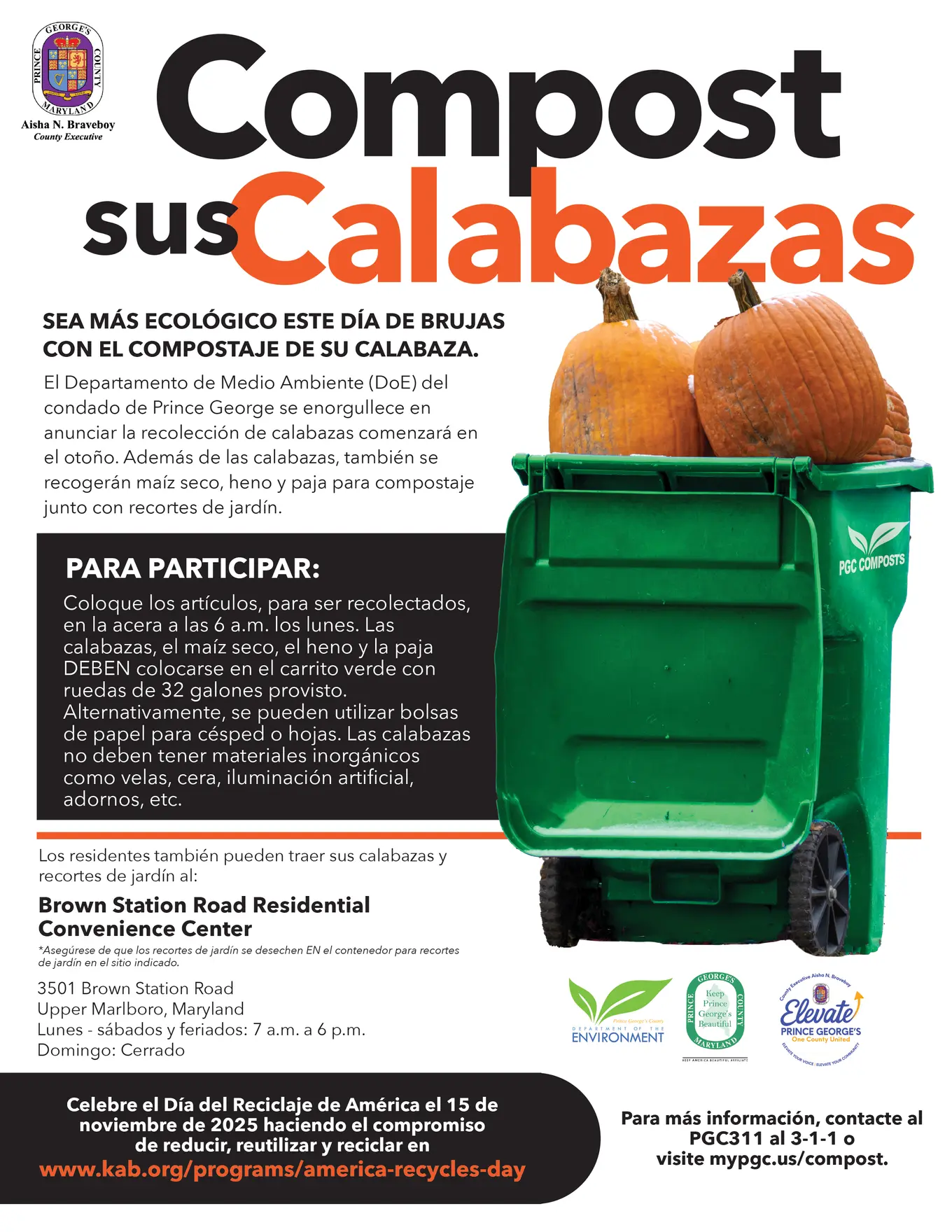
Organics Composting Facility
Physical Address: 6550 Maude Savoy Brown Road. Upper Marlboro, MD 20772.
Mailing Address: 6601 SE Crain Highway, Upper Marlboro, MD 20772
Hours of Operation: Monday through Friday - 7:00 a.m. to 3:00 p.m.
To service the County’s residential collection routes, on Mondays, no cash or credit card transactions/customers will be accepted. Cash and credit card-paying customers may access the facility Tuesday through Friday.
Prince George's County Government contracts with Maryland Environmental Services (MES) to operate the Organics Composting Facility (OCF) in Upper Marlboro, MD. Yard trim (including grass clippings, leaves, brush, small branches, and Christmas trees), is collected from more than 180k households in the County and delivered to the facility. Once the yard trim is delivered, it is ground, placed in windrows and processed into compost. The compost, known as Leafgro®, is sold to wholesalers in bulk. Residents may buy Leafgro® from retailers.
Processing
Over 50,000 tons of material is processed annually at the Prince George's County Organics Composting Facility. Yard trim and food scraps are ground up and moved into long, narrow piles known as windrows. In the fall, windrows are comprised primarily of leaves. In the spring, grass is added. The active composting phase requires both leaves and grass. Windrow composting is most effective when the carbon to nitrogen ratio is 25 parts carbon to 1 part nitrogen; the temperature ranges between 130 to 140 degrees Fahrenheit, the moisture is between 45% and 55%, and the oxygen is more than 5%.
Windrow Composting
Windrows are turned using a Scarab windrow turner to accelerate the composting process. The frequency of turning depends on environmental conditions. In general, windrows are turned more frequently during the spring and summer (approximately 2 turns per week). Depending on the weather, the rows of yard trim may require manual watering. Normally, our area receives enough rainfall and moderate temperatures to avoid manual watering. However, in drought conditions or extremely hot weather, watering becomes necessary. The windrow composting process takes approximately 9 months to complete.
The material is then moved to a curing pile, where it will continue to decompose for approximately three months. Next, it is screened to remove all particles larger than 3/8 inch.
Leafgro®
The final product is a dark humus-like material marketed as Leafgro® by MES. It is produced in accordance with the Maryland Department of Agriculture regulations and is a great soil amendment. A network of retailers sells the Leafgro®. Revenue from the sale of this material is returned to the county to offset the cost of the composting operation.
Food Scrap Composting
Prince George’s County piloted food scrap composting in 2013 utilizing the GORE® Cover technology,, an in-vessel aerated pile system with oxygen and temperature monitoring devices. This technology creates ideal composting conditions within the pile while efficiently trapping odors and other emissions, such as dust and volatile organic compounds (VOCs). This system allows for processing a greater volume of yard trim and including food scraps on a smaller footprint of the area with little energy consumption and creates finished compost within 60 days. Utilizing the GORE® Cover system enables the County to divert food scraps from the landfill increasing the overall recycling rate within the County.
The final product from this process is known as Leafgro GOLD®, a nutrient-rich dark humus-like material marketed by the County’s contractor, MES. The compost is produced in accordance with the Maryland Department of Agriculture regulations and is a top-quality soil amendment. A network of retailers found on MES’s website, sells the Leafgro GOLD®. Revenue from the sale of this material is returned to the County to offset the cost of the composting operation.
In 2014, the County increased the GORE® Cover system from a three-heap pilot project to a four-heap continuous process. The composting of food scraps and yard trim mixed together in the GORE® Cover system has been so successful that another expansion to an eight-heap system is in process. Food scraps are accepted from pre- and post-consumer entities, including residential, commercial, and institutional sectors.
Scheduled Tours
Tours at the OCF have resumed and are available to the public, including schools, colleges, civic and church groups, scout troops, Federal Agencies, and foreign delegations. For further information and to schedule a tour, please contact the OCF at 301-627-6388. Tours are conducted Monday through Friday from 8 a.m. to 3 p.m.
Visitor's Center
County citizens and residents are invited to tour the Visitor's Center at the Prince George's County Organics Composting Facility. Through the informational displays, visitors will learn about the facility's composting process, the many recycling programs offered by the County, and backyard composting.
Special Events & Attractions
Mulch Madness Giveaway
The Resource Recovery Division (RRD) sponsors a Mulch Madness giveaway in the spring to provide County residents with free mulch. The mulch for this event is derived from Christmas trees collected or dropped off for recycling.
The Mulch Madness source reduction event is in conjunction with Earth Day and is just one of the many departmental programs celebrating Earth Month in April!
Residents transporting mulch by car must bring their own containers and shovels or pitchforks. A skid loader will be available to load mulch directly into pickup trucks.
For more information and specific dates for the next Mulch Giveaway, check the local paper, our Mulch Madness page, website, or contact PGC311.
Pumpkin Composting
The Prince George’s County Department of the Environment (DoE) is pleased to announce that pumpkin collection will begin in the fall. In addition to pumpkins, dried corn, hay, and straw will also be picked up for composting, along with yard trim.
Items should be placed curbside by 6:00 a.m. on Mondays for pickup. Pumpkins, dried corn, hay, and straw MUST be placed in the provided 32-gallon green wheeled cart. Alternatively, paper lawn/leaf bags can be used. Pumpkins must be free of inorganic materials such as candles, wax, artificial lighting, loose decorations, etc.
Residents may also drop-off pumpkins and other yard trim at the Brown Station Road Residential Convenience Center located at 3501 Brown Station Road. Upper Marlboro, MD. Open Monday - Saturdays and holidays from 7 a.m. to 6 p.m. Closed on Sundays. Please make sure yard trim is disposed of IN the Yard Trim Container on Site.
 |
 |
Live Christmas/ Holiday Tree Recycling
The Department of the Environment makes it easy for residents to "recycle" cut, live Christmas trees (no artificial trees) by offering curbside pickup and a drop-off location.
Christmas tree collection runs through January, every year. Residents with County-provided yard trim collection can place their undecorated, unbagged, live Christmas trees at the curb by 6 a.m. on Mondays.
During operating hours, residents may also drop off holiday trees and other yard trim at the Public Convenience Center on Brown Station Road in Upper Marlboro.
Please be sure to remove all artificial items and decorations.
